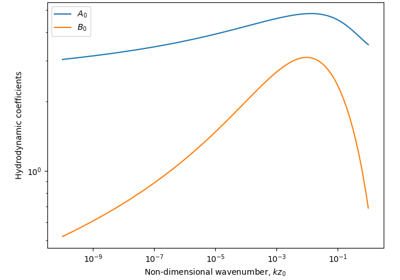pydune.physics.solve_turbulent_flow#
- solve_turbulent_flow(model, parameters, Kappa=0.4, max_z=None, method='DOP853', atol=1e-10, rtol=1e-10, **kwargs)[source]#
This function solves the perturbation of the flow induced by a sinusoidal bottom in various configurations. The description of each configuration and associated parameters is done in the description of the module.
Warning
The solver performs poorly for too large integration domains due to accumulation of numerical errors. In practice, the user should be carefull when using values of eta_H (\(\eta_{H} = k H\)) larger than 10.
- Parameters:
model (str) – Chosen configuration. It can be
'1D_unbounded','1D_freesurface','1D_freeatmosphere'or'2D_unbounded'.parameters (dict) –
Dictionnary containing the physical parameters necessary for solving each models. For each model, the list of parameters the dictionnary must contain is:
1D_unbounded:
eta_0,eta_H1D_freesurface:
eta_0,eta_H,Fr1D_freeatmosphere:
eta_0,eta_H,eta_B,Fr2D_unbounded:
eta_0,eta_H,Fr,alpha
Kappa (float, optional) – Von Karmàn constant (the default is 0.4).
max_z (float, optional) – Maximum vertical position where the system is solved, and also where the boundary conditons are applied. Usually set to something slightly smaller than eta_H to avoid the very slow resolution close to the top of the boundary layer. Usefull when investigating the solution close to the bottom (the default is
eta_H).method (str, optional) – Numerical method used to solve the equations. It is passed to the solver
solve_ivp(default isDOP853, which corresponds to an Explicit Runge-Kutta method of order 8 with an adaptative time-step).atol (float, optional) – Absolute tolerance. The solver keeps the local error estimate smaller than \(atol + rtol*abs(y)\), where \(y\) is the solution at a given time step. More information can be found in the documentation of
solve_ivp(the default is 1e-10 for both).rtol (float, optional) – Absolute tolerance. The solver keeps the local error estimate smaller than \(atol + rtol*abs(y)\), where \(y\) is the solution at a given time step. More information can be found in the documentation of
solve_ivp(the default is 1e-10 for both).**kwargs (optional) – Any other optional parameters that can be passed to
solve_ivp.
- Returns:
solution – function calculating the solution by taking as argument values of the vertical coordinate \(\eta = k z\) (float, array_like). It is built from seleveral
ODE_solution. See corresponding documentation for more information about the interpolation algorithm. Ifmodel = '1D_freeatmosphere', return also a function calculating the streamfunction above eta_H. Its arguments are, in this order: - vertical coordinate \(\eta = k z\), numpy array - the horizontal coordinate \(\eta = k x\), numpy array, - aspect ratio the bottom perturbation \(\eta = k \xi\) (float)- Return type:
func, list of func
References
[1] Fourrière, A. (2009). Morphodynamique des rivières: Sélection de la largeur, rides et dunes (Doctoral dissertation, Université Paris-Diderot-Paris VII).[2] Fourriere, A., Claudin, P., & Andreotti, B. (2010). Bedforms in a turbulent stream: formation of ripples by primary linear instability and of dunes by nonlinear pattern coarsening. Journal of Fluid Mechanics, 649, 287-328.[3] Andreotti, B., Fourriere, A., Ould-Kaddour, F., Murray, B., & Claudin, P. (2009). Giant aeolian dune size determined by the average depth of the atmospheric boundary layer. Nature, 457(7233), 1120-1123.[4] Andreotti, B., Claudin, P., Devauchelle, O., Durán, O., & Fourrière, A. (2012). Bedforms in a turbulent stream: ripples, chevrons and antidunes. Journal of Fluid Mechanics, 690, 94-128.
Examples using pydune.physics.solve_turbulent_flow#

Properties of a turbulent flow on a sinusoidal bottom